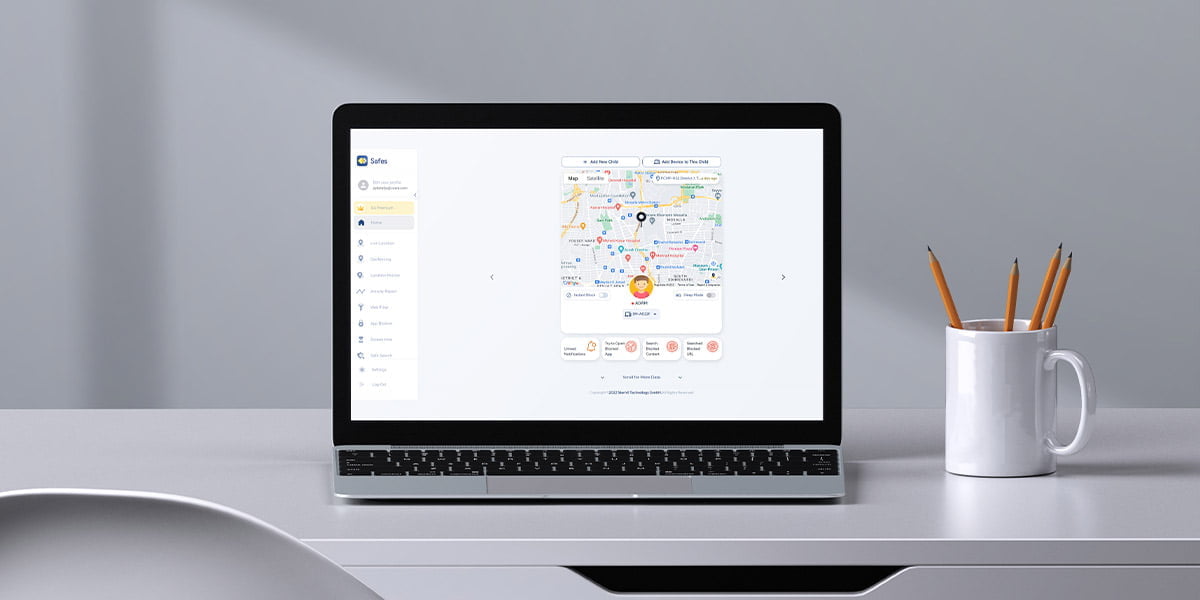Parents lock websites to protect children from inappropriate content, prevent access to time-wasting platforms during study hours, and block potentially harmful sites, including adult content, gambling, and social media. You can put a parental control lock on websites through four main methods: browser extensions and built-in settings, router-based filtering, device-specific parental controls, or comprehensive parental control apps.
Download and Start Your Free Trial of the Safes Parental Control App
- Browser method: Install extensions like BlockSite or use built-in restrictions (limited to specific browsers)
- Router filtering: Block websites network-wide through router admin settings (affects all devices)
- Device controls: Use built-in parental controls on iOS, Android, Windows, or Mac (device-specific)
- Parental control apps: Install comprehensive solutions for multi-device, cross-platform protection
- Common blocked sites: Adult content, gambling sites, social media, gaming platforms, video streaming during study time
Why Parents Need Website Locks
The digital landscape presents both opportunities and risks for children. With 79% of kids aged 15-24 spending significant time online, parents face the challenge of ensuring safe internet access. Research shows that 39% of parents currently use parental controls for blocking, filtering, or monitoring their teens’ online activities, while 46% of teens report being online almost constantly.
Understanding what parental control is helps parents choose the most effective protection methods for their family’s digital environment. Parents use them to enforce digital boundaries during homework time, prevent access to distracting entertainment sites during study hours, and maintain age-appropriate browsing habits. The goal isn’t complete internet restriction but rather creating structured, safe digital environments.
Available Methods for Website Blocking
Four primary approaches exist for putting parental control locks on websites, each with distinct advantages and limitations:
Manual browser and site settings work through individual browser configurations or browser extensions. These affect only specific browsers and require setup on each browser your child uses.
Router-based filtering controls internet access at the network level, affecting all devices connected to your home WiFi. This method blocks websites for every device simultaneously, but it doesn’t work when children use cellular data or other networks.
Device-specific parental controls use built-in operating system features on phones, tablets, and computers. iOS, Android, Windows, and Mac all include website blocking capabilities, but settings must be configured separately on each device.
Comprehensive parental control applications provide unified control across multiple devices and platforms. These apps typically offer the most features but require subscription fees and installation on each monitored device.
Browser-Based Website Blocking
Browser-based website blocking works through extensions, add-ons, or built-in browser settings to restrict access to specific websites. This method affects only the particular browser where restrictions are configured, meaning children can potentially bypass controls by using different browsers unless each one is individually secured.
How to Put a Parental Lock on Websites on Chrome
Chrome requires third-party extensions for website blocking since Google removed built-in parental controls. Popular options include BlockSite and StayFocusd.
Install BlockSite from the Chrome Web Store, then add specific website URLs to your block list. The extension allows password protection of settings and scheduled blocking for specific time periods. To access BlockSite settings, click the extension icon and navigate to the dashboard, where you can add websites, set time restrictions, and configure break periods.
For additional protection, learn how to block websites on Chrome mobile for comprehensive mobile device security. Navigate to Settings > Privacy and Security > Security > SafeSearch to filter explicit content from search results.
How to Put a Parental Lock on Websites on Firefox
Firefox supports website blocking through extensions like uBlock Origin and FoxFilter. These tools offer more granular control than Chrome alternatives.
Download uBlock Origin from Mozilla Add-ons, then access the extension dashboard to configure custom filter lists. You can block specific domains, create whitelists for educational sites, and set up time-based restrictions. Firefox’s enhanced tracking protection also helps reduce exposure to potentially harmful advertisements.
Safari Website Restrictions
Safari integrates with iOS and macOS parental controls for seamless website blocking. On Mac, access restrictions are found through System Preferences > Screen Time > Content & Privacy Restrictions. Enable website filtering and choose between limiting adult websites automatically or creating custom allowed/blocked lists.
Router-Level Website Filtering
Router-based filtering affects all devices connected to your home network simultaneously. This method prevents circumvention through different browsers or devices but requires technical setup.
Access your router’s admin panel by typing the router’s IP address (typically 192.168.1.1 or 192.168.0.1) into a web browser. Login credentials are usually printed on the router itself or found in the manual. Navigate to the parental controls or access restrictions sections.
Most modern routers include built-in website filtering capabilities. You can block specific domains, set time-based restrictions, and create different access levels for different family members. Some routers also support third-party DNS filtering services like OpenDNS or CleanBrowsing for enhanced protection.
The limitation of router-based filtering is that it only works on your home network. Children can bypass these restrictions using cellular data or accessing the internet through other WiFi networks.
Device-Specific Controls
Device-specific parental controls utilize built-in operating system features to restrict website access across all browsers and apps on individual devices. These controls typically integrate deeply with the device’s security framework, making them more difficult to bypass than browser-based solutions while offering comprehensive protection for that specific device.
How to Put a Parental Lock on Websites on iOS
iOS includes comprehensive built-in parental controls through Screen Time settings. Navigate to Settings > Screen Time > Content & Privacy Restrictions > Content Restrictions > Web Content.
Choose from three options: unrestricted access, limit adult websites automatically, or allow websites only. The automatic adult website filtering blocks known inappropriate content while allowing educational and general websites. For stricter control, use the “allowed websites only” option to create a curated list of permitted sites.
You can also add specific websites to block, even when using the automatic filtering option. Enter URLs in the “Never Allow” section to prevent access regardless of other settings.
How to Put a Parental Lock on Websites on Android
Android devices require third-party applications for comprehensive website blocking since Google removed built-in parental controls from recent Android versions. Google Family Link provides some website filtering capabilities for child accounts.
Install Family Link on both parent and child devices, then configure website restrictions through the parent app. You can block specific sites, manage app downloads, and set screen time limits. Family Link works with the Chrome browser but may not affect other browsers installed on the device.
For more comprehensive control, consider installing dedicated website blocking apps like BlockSite or Mobicip directly on the Android device.
How to Put a Parental Lock on Websites on Windows
Windows includes built-in family safety features through Microsoft Family accounts. Create a child account through the Microsoft Family website, then configure website restrictions remotely.
Windows blocks inappropriate websites automatically when using the Microsoft Edge browser. You can view blocked attempts, add specific sites to allow or block lists, and receive weekly activity reports. To access these settings, sign in to the Microsoft Family website and select your child’s account.
For blocking websites across all browsers on Windows, modify the hosts file located at C:\Windows\System32\drivers\etc\hosts. Add entries in the format “127.0.0.1 websitename.com” to redirect blocked sites to localhost. This method requires administrator access and technical knowledge.
How to Put a Parental Lock on Websites on a Mac
Mac computers integrate website blocking through Screen Time controls. Access these settings through System Preferences > Screen Time > Content & Privacy Restrictions.
Enable content restrictions and navigate to web content settings. Choose automatic filtering for adult content or create specific allowed/blocked website lists. Mac also supports downtime scheduling to limit internet access during specific hours.
For broader device protection, parents should also consider learning how to put parental controls on computer systems beyond just website blocking. This method works across all browsers but requires administrator privileges and comfort with command-line interfaces.
Comprehensive Parental Control Apps
While built-in controls offer basic website blocking, comprehensive parental control apps provide enhanced features across multiple devices and platforms. These solutions typically include advanced monitoring, detailed reporting, and unified management interfaces.
Leading parental control applications offer cross-platform compatibility, working on iOS, Android, Windows, and Mac devices simultaneously. They provide real-time alerts when children attempt to access blocked content, detailed activity reports, and remote management capabilities.
Many apps include artificial intelligence-powered content analysis that can identify and block inappropriate material even on previously unknown websites. This dynamic protection adapts to new threats automatically without requiring manual updates to block lists.
For families seeking comprehensive digital protection, Safes provides robust website filtering, app blocking, screen time management, and location tracking across all major platforms. The service includes keyword filtering to block inappropriate search terms and scheduled restrictions for different times of day.

Types of Websites Parents Commonly Block
Understanding which types of websites pose risks helps parents make informed decisions about content filtering. Common categories include:
Understanding inappropriate content helps parents identify which websites and platforms require blocking or monitoring. These sites can expose children to inappropriate sexual material and unrealistic depictions of relationships and body image.
Gambling and betting websites target users with addictive game mechanics and potential financial risks. Many gambling sites don’t verify age properly, making them accessible to minors.
Social media platforms during study hours help maintain focus on educational activities. Parents often block Facebook, Instagram, TikTok, and Snapchat during homework time while allowing access during recreational hours.
Video streaming and entertainment sites like YouTube, Netflix, and gaming platforms can be restricted during study time to prevent distraction. Many parents allow supervised access to educational content while blocking entertainment videos during designated hours.
File sharing and torrent sites pose risks, including malware, copyright infringement, and exposure to inappropriate content. These platforms often contain unmoderated material unsuitable for children.
Anonymous communication platforms like certain chat rooms and messaging apps can expose children to cyberbullying, online predators, and harmful peer pressure situations.
Violent or extreme content, including sites promoting self-harm, eating disorders, or extremist ideologies, requires blocking to protect vulnerable young users from harmful influences.
Understanding these categories helps parents implement targeted filtering strategies that protect children while maintaining access to beneficial online resources.
Comparing Website Blocking Methods
| Method | Coverage | Setup Difficulty | Circumvention Risk | Cost |
|---|---|---|---|---|
| Browser Extensions | Single browser only | Easy | High (different browsers) | Free |
| Router Filtering | All home devices | Moderate | Medium (mobile data) | Free |
| Device Controls | Single device | Easy to Moderate | Medium (other devices) | Free |
| Parental Control Apps | All devices/platforms | Easy | Low (comprehensive) | Paid subscription |
| DNS Filtering | Network-wide | Moderate | Medium (alternative DNS) | Free or Paid |
Browser-based solutions work well for younger children using supervised devices, but become less effective as children gain technical knowledge. Router filtering provides broad coverage but fails when children use cellular data or visit friends’ homes.
Device-specific controls offer good protection for individual devices but require configuration on every device a child might use. This approach becomes cumbersome for families with multiple devices or children who frequently use different devices.
Comprehensive parental control apps provide the most thorough protection by combining multiple blocking methods and offering centralized management. While they require subscription fees, the enhanced features and cross-platform compatibility often justify the investment for families serious about digital safety.
The most effective approach typically combines multiple methods, such as router-level filtering for basic protection supplemented by device-specific controls or parental control apps for detailed monitoring and management.
Implementing Effective Website Filtering
Successful website filtering requires balancing protection with practical usability. Start with broader categories of harmful content and gradually refine restrictions based on your family’s specific needs and your children’s maturity levels.
Regular review and updates ensure filtering remains effective as children grow and internet threats evolve. What works for a 10-year-old may be too restrictive for a 15-year-old, requiring ongoing adjustment of permissions and blocked categories.
Parents should also educate children about online safety tips as part of a comprehensive digital protection strategy. Explain to children why certain restrictions exist and involve age-appropriate children in discussions about digital safety. This approach builds understanding and cooperation rather than resentment toward protective measures.
Consider implementing graduated freedoms as children demonstrate responsible internet use. Temporary lifting of restrictions for specific research projects or supervised browsing helps children develop good digital citizenship skills while maintaining overall protection.
Testing and monitoring ensure your chosen method works as intended. Periodically verify that blocked sites remain inaccessible and that legitimate educational resources remain available. Regular activity reports help identify new risks or areas where adjustments might be needed.
Conclusion
Putting a parental control lock on websites involves choosing the right combination of tools and strategies for your family’s specific needs. Browser extensions work for basic blocking, router filtering provides network-wide protection, device controls offer integrated solutions, and comprehensive parental control apps deliver the most thorough protection across all platforms.
The key to successful website filtering lies in understanding the strengths and limitations of each method, implementing appropriate restrictions for your children’s ages and maturity levels, and maintaining open communication about digital safety. Regular review and adjustment ensure your protective measures evolve with your family’s changing needs.
Consider starting with built-in device controls for immediate protection, then evaluating whether additional tools like router filtering or comprehensive parental control apps would benefit your specific situation. The most effective protection often combines multiple approaches rather than relying on a single solution.
To complement our detailed instructions on how to put a parental lock on websites, we’ve created an engaging video tutorial that visually walks you through the entire process. This step-by-step video guide is designed to provide you with a clear, easy-to-understand demonstration, making it simpler than ever to set up robust parental controls. Whether you’re aiming to protect your children from inappropriate content or manage their online time effectively, the tutorial below will show you exactly how to customize these settings for a safer internet experience.
Frequently Asked Questions
What is the most effective way to put a parental lock on websites?
Comprehensive parental control apps provide the most effective website blocking because they work across all devices and platforms simultaneously. They combine multiple blocking methods, offer real-time monitoring, and adapt to new threats automatically. For families wanting maximum protection, apps like Safes provide unified control over all family devices through a single dashboard.
Can children bypass parental controls on websites?
Determined children can circumvent most website blocking methods through various techniques, including using different browsers, mobile data instead of home WiFi, VPN services, or accessing sites through proxy servers. The most circumvention-resistant approaches combine multiple blocking methods and include monitoring features that alert parents to bypass attempts.
How do I block websites on all devices at once?
Router-level filtering blocks websites on all devices connected to your home network simultaneously. Configure website blocking through your router’s admin panel to affect computers, phones, tablets, and smart devices at once. However, this method doesn’t work when devices use cellular data or connect to other networks.
Which websites should parents block for children?
Parents commonly block adult content, gambling sites, social media during study hours, file-sharing platforms, anonymous chat rooms, and sites promoting harmful behaviors. The specific sites to block depend on your child’s age, maturity level, and your family’s values. Start with obviously inappropriate content and adjust based on your child’s needs and demonstrated responsibility.
Do free parental control methods work as well as paid apps?
Free built-in controls provide basic website blocking but lack advanced features like cross-platform synchronization, detailed reporting, and intelligent content analysis. Paid parental control apps offer more comprehensive protection, better circumvention resistance, and enhanced monitoring capabilities. For families needing basic protection, free methods may suffice, but comprehensive solutions typically require paid services.
Your Child’s Online Safety Starts Here
Every parent today needs a solution to manage screen time and keep their child safe online.
Without the right tools, digital risks and excessive screen time can impact children's well-being. Safes helps parents set healthy boundaries, monitor activity, and protect kids from online dangers—all with an easy-to-use app.
Take control of your child’s digital world. Learn more about Safes or download the app to start your free trial today!




